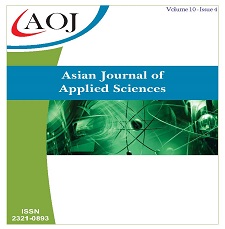UV –Visible Spectroscopy Method Development and Its Validation for the Analysis of Marketed Hair Dyes for Amine Content
DOI:
https://doi.org/10.24203/ajas.v10i4.7026Keywords:
Para Phenylenediamine , folins reagent Spectrophotometric methodAbstract
To develop a simple rapid, accurate and spectrophotometric reproducible method were developed for estimation of PARA - PHENYLENE DIAMINE in different Marketed Hair dyes . The analysis of PPD was performed using NaOH solution as diluent and using folins reagent at 432nm respectively .The methods were linear in the concentration range from 0-50µg/ml. The methods were validated with respect to system suitability, linearity, precision, limit of detection, limit of quantification, accuracy, ruggedness and robustness . The developed method can be used for routine analysis of PARA PHENYLENE DIAMINE in marketed hair products. The methods were validated in accordance to the ICH guidelines.
References
.Pasricha, J.S.; Grupta, R.; Panjwani, S. Contact dermatitis to henna (Lawsonia). Contact Dermatitis 1980, 6, 288-289.
. Zapolanski, T; Jacob, S.E. Para-Phenylenediamine. Dermatitis 2008, 19, 20-21.
. Deleo, V.A. P-Phenylenediamine. Dermatitis 2006, 17, 53-55.
. Lepoittevin, P.; LeCoz, C.J. Paraphenylenediamine. In Dictionary of Contact Allergens, 1st ed.; Springer: Berlin, Germany, 2007; p. 194.
.Schnuch, A.; Lessmann, H.; Frosch, P.J.; Uter, W. Para-Phenylenediamine: the profile of an important allergen. Results of the IVDK. Br. J. Dermatol. 2008, 159, 379-386.
. Chung, W.H.; Chang, Y.C.; Yang, L.J; Hung S.I.; Wong W.R.; Lin J.Y.; Chan H.L. Clinico-pathologic features of skin reactions to temporary tattoos and analysis of possible causes. Arch. Dermatol. 2002, 38, 88-92.
. Kind F, Scherer K, Bircher AJ, Contact dermatitis to para-phenylenediamine in hair dye following sensitization to black henna tattoos-an ongoing problem, J Dtsch Dermatol Ges 10(8), 572-578, 2012.
. Jacob SE, Zapolanski T, Chayavichitsilp P, Sensitivity to para-phenylenediamine and intolerance to hydrochlorothiazide, J Dermatitis 19(6), 44 - 45, 2008.
Lepoittevin P, LeCoz CJ, Paraphenylenediamine. In: Dictionary of Contact Allergens, Ed (1): Springer, pp. 194-196, Berlin, Germany, 2007.
. Stanley LA, Skare JA, Doyle E, Powrie R, D'Angelo D, Elcombe CR, Lack of evidence for metabolism of phenylenediamine by human hepatic cytochrome P450 enzymes, J Toxicol 210(2- 3), 147-157, 2005.
. Khuhro BA, Khaskheli MS, Shaikh AA. Paraphenylenediamine poisoning: Our experience at PMC Hospital Nawabshah. Anaesth, Pain & Intensive Care.2012;16(3):243-46.
. Bhargava P, Matthew P. Hair Dye Poisoning. J Assoc Physicians India. 2007;55:871–2. Nott HW. Systemic Poisoning by Hair Dye. Br Med J 1924;1:421-2.
. Soni SS, Nagarik AP, Dinaker M, Adikey GK, Raman A. Systemic toxicity of paraphenylenediamine. Indian J med Sci 2009; 63: 164-6.
. Chugh KS, Malik GH, Singhal PC. Acute renal failure following paraphenylenediamine (hair dye) poisoning. Report of 2 cases. J. Med 1982; 13:131-137.
. Kallel H, Chelly H, Dammak H, Bahloul M, Ksibi H, HamidaCb et al. Clinical Manifestations of Systemic Paraphenylenediamine Intoxication. J Nephrol. 2005; 18(3): 308-11.
. Suliman SM, Fadlalla M, Nasr Mel M, et al. Poisoning With Hair Dye Containing Paraphenylenediamine: Ten Year Experience. Saudi J Kidney Dis Transpl 199
Downloads
Published
Issue
Section
License
Copyright (c) 2022 Bhavyasri Khagga, K. AmukthaMalyada, M. Sumakanth

This work is licensed under a Creative Commons Attribution-NonCommercial 4.0 International License.
Copyright © The Author(s). This article is published under the Creative Commons Attribution License (CC BY 4.0), which permits unrestricted use, distribution, and reproduction in any medium, provided the original work is properly cited.


